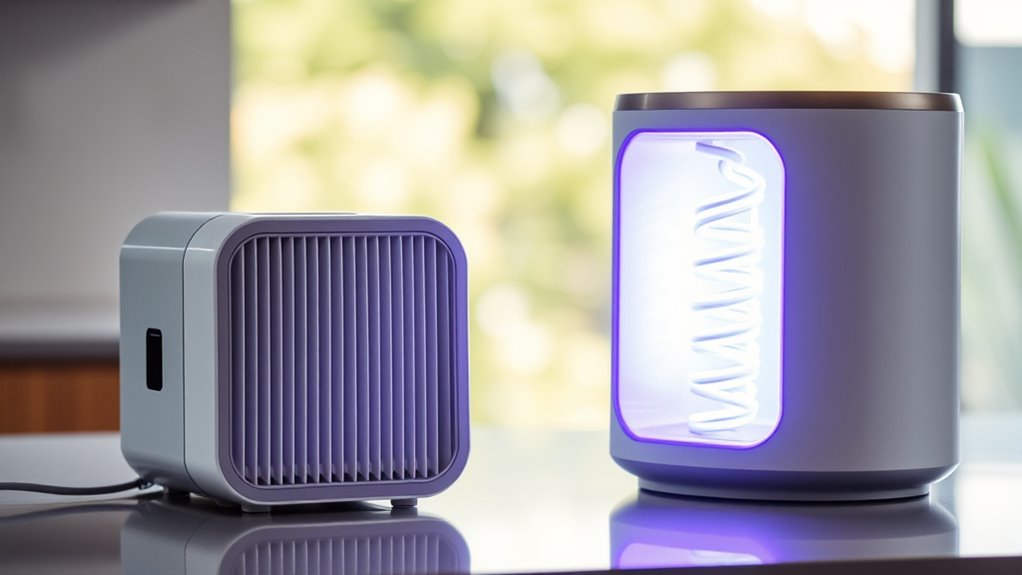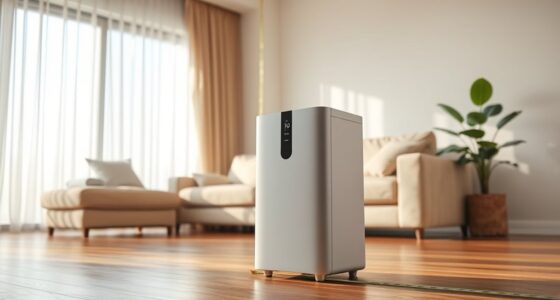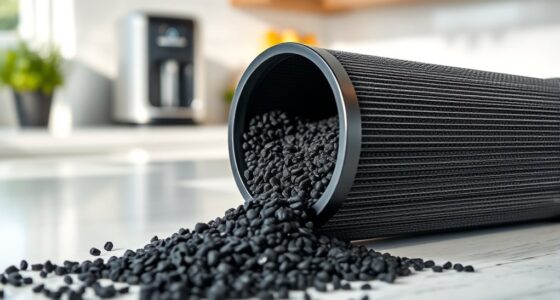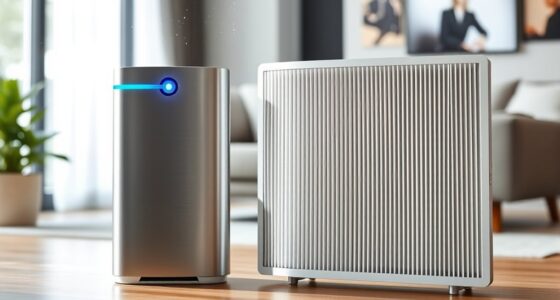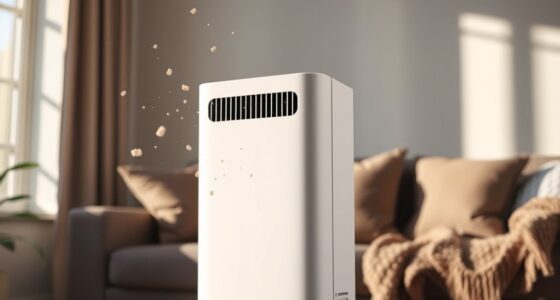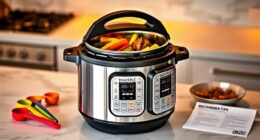HEPA filters trap tiny particles like dust, pollen, and pet dander, helping you breathe easier and reducing allergy symptoms. UV purifiers use ultraviolet light to kill germs, bacteria, and viruses, preventing airborne infections. Each technology targets different contaminants, so combining them offers a thorough solution. If you’re curious about which option suits your needs best or how they work together, there’s more to discover below.
Key Takeaways
- HEPA filters trap tiny airborne particles like dust and pollen, removing allergens and pollutants from indoor air.
- UV purifiers use ultraviolet light to destroy microorganisms such as bacteria, viruses, and mold spores.
- HEPA is ideal for allergy sufferers by reducing allergens; UV is effective in controlling microbial contamination.
- Many air purifiers combine both HEPA and UV technologies for comprehensive removal of particles and germs.
- Choose HEPA for particulate removal or UV for pathogen control, depending on your specific air quality needs.
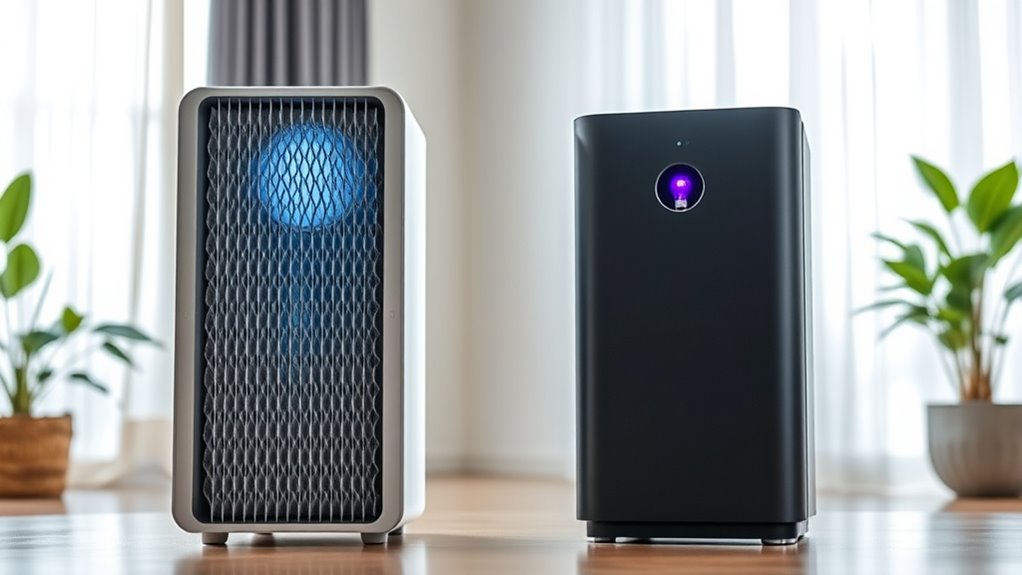
HEPA filters, or High-Efficiency Particulate Air filters, are designed to trap tiny particles suspended in the air. They are capable of capturing 99.97% of particles as small as 0.3 microns, including dust, pollen, pet dander, mold spores, and even some bacteria. When you opt for a HEPA air purifier, you’re investing in a technology that physically removes allergens and pollutants, making it highly effective for allergy sufferers and those concerned with airborne irritants. The health benefits of using a HEPA filter are well-documented: reduced allergy symptoms, fewer asthma attacks, and an overall cleaner living environment. Because HEPA filters continuously trap particles as air circulates through the device, they create a safer, healthier indoor space, especially in environments with high allergen levels. Additionally, HEPA filters are essential in vetting allergy triggers, helping to maintain a cleaner indoor environment for sensitive individuals.
UV air purifiers, on the other hand, rely on ultraviolet light to disinfect the air by destroying or neutralizing microorganisms such as bacteria, viruses, and mold spores. UV technology is a form of air purification that targets biological contaminants at a cellular level, preventing their proliferation. This process is especially valuable in environments where controlling pathogens is a priority, like healthcare settings or homes with immunocompromised individuals. While UV purifiers are excellent at reducing the spread of germs, they don’t necessarily remove dust, pollen, or chemical pollutants from the air. The health benefits here are focused on minimizing microbial contamination, which can reduce the risk of infections and respiratory illnesses caused by airborne bacteria and viruses.
In practice, many modern air purifiers combine HEPA and UV technologies, providing extensive air cleaning that addresses both particulate matter and biological contaminants. If your primary concern is removing allergens and pollutants, a HEPA filter might be your best choice. If you’re more worried about germs and microbial contamination, then a UV-based purifier or a model that combines both technologies could be ideal. Ultimately, understanding the differences in air purification technologies helps you make informed decisions, ensuring you select an air purifier that offers the best health benefits for your specific environment.
Frequently Asked Questions
Are UV Air Purifiers Safe for Children and Pets?
You might wonder if UV air purifiers are safe for children and pets. Generally, they’re designed to be safe, as UV light is contained within the device and doesn’t emit harmful radiation. However, for child safety and pet health, verify the purifier is certified and has safety features like enclosed UV bulbs. Always follow manufacturer instructions, and consider models with additional safety measures to keep your family and pets safe.
How Often Do HEPA Filters Need Replacement?
Filter freshness and lifespan matter! Typically, HEPA filters need replacement every 6 to 12 months, depending on usage and air quality. Regularly check the filter’s condition for dirt and debris, as a clogged filter can reduce efficiency. To maintain peak air purity, follow the manufacturer’s guidelines for replacement frequency, and consider your home’s environment to determine the best schedule for changing your HEPA filter.
Can UV Purifiers Eliminate All Viruses?
You might wonder if UV purifiers can eliminate all viruses. While UV light, especially with high UV intensity, effectively causes viral inactivation by damaging their DNA or RNA, it doesn’t guarantee complete removal. Factors like exposure time and virus type matter. So, UV purifiers greatly reduce viruses, but for thorough protection, combining them with other filters like HEPA is recommended.
Do Both Types Produce Ozone or Other Harmful Byproducts?
Think of air purifiers as guardians battling unseen foes; some produce ozone, a harmful byproduct, while others don’t. Both UV and HEPA purifiers can produce ozone or other harmful byproducts if not properly designed or used. UV purifiers may generate ozone during the process, and certain HEPA units might emit trace amounts. Always verify ozone production ratings to guarantee your purifier keeps your air clean without introducing new risks.
Which Purifier Is More Energy-Efficient for Long-Term Use?
When choosing a purifier for long-term use, consider energy consumption and maintenance costs. HEPA filters typically use less energy because they rely on a fan to trap particles, making them more efficient over time. UV purifiers may consume more power due to the UV light, and their bulbs require regular replacement, increasing maintenance costs. Overall, HEPA units often offer better energy efficiency for ongoing use.
Conclusion
Now that you know the difference between HEPA and UV air purifiers, you’re better equipped to choose the perfect shield for your space. Whether you need the powerhouse filtration of HEPA or the germ-zapping magic of UV, your air quality will skyrocket. Think of it as arming your home with a fortress so mighty, even the tiniest airborne invaders don’t stand a chance. Make your choice today and breathe easier like never before!
